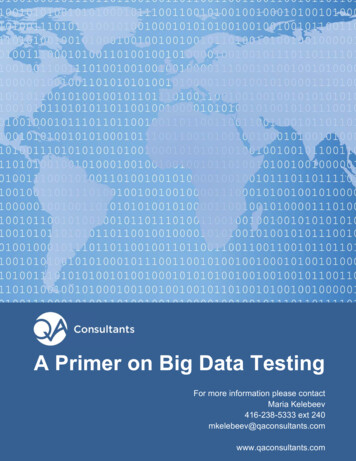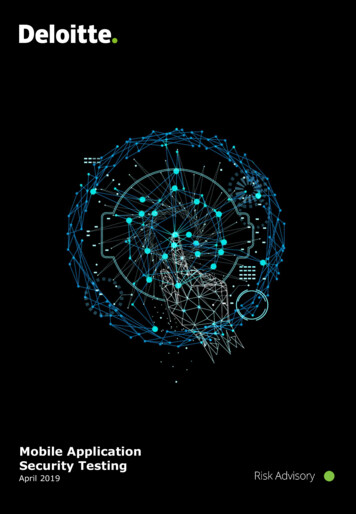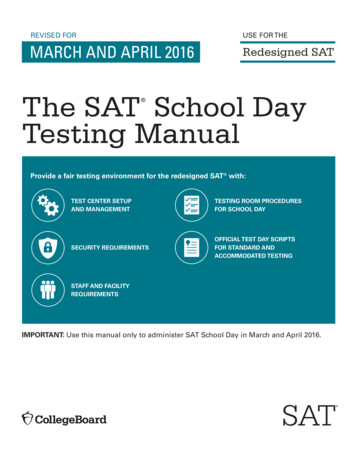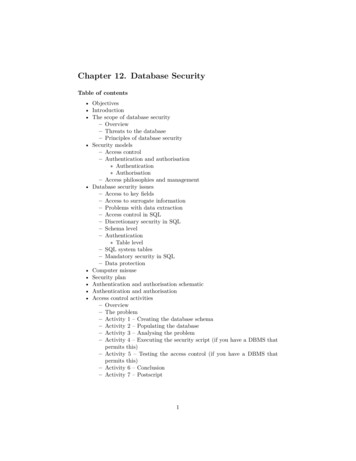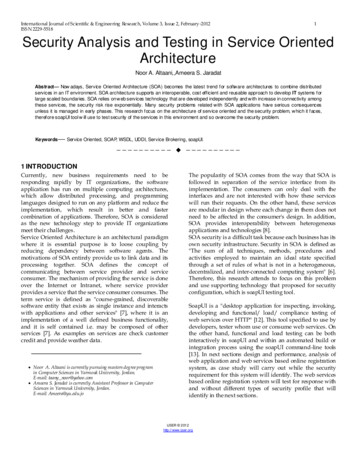
Transcription
International Journal of Scientific & Engineering Research, Volume 3, Issue 2, February -2012ISS N 2229-55181Security Analysis and Testing in Service OrientedArchitectureNoor A. Altaani,,Ameera S. JaradatAbstract— Now adays, Servic e Oriented Architecture (SOA) becomes the latest trend for softw are architectures to combine distributedservices in an IT environment. SOA architecture supports an interoperable, cost efficient and reusable approach to develop IT systems forlarge scaled boundaries. SOA relies on web services technology that are developed independently and with increase in connectivity amongthese services, the security risk rise exponentially. Many security problems related with SOA applications have serious consequencesunless it is managed in early phases. This research focus on the architecture of service oriented and the security problem, which it faces,therefore soapUI tool w ill use to test security of the services in this environment and so overcome the security problem.Keywords — Servic e Oriented, SOAP, WSDL, UDDI, Service Brokering, soapUI.—————————— ——————————1 INTRODUCTIONCurrently, new business requirements need to beresponding rapidly by IT organizations, the softwareapplication has run on multiple computing architectures,which allow distributed processing, and programminglanguages designed to run on any platform and reduce theimplementation, which result in better and fastercombination of applications. Therefore, SOA is consideredas the new technology step to provide IT organizationsmeet their challenges.Service Oriented Architecture is an architectural paradigmwhere it is essential purpose is to loose coupling byreducing dependency between software agents. Themotivations of SOA entirely provide us to link data and itsprocessing together. SOA defines the concept ofcommunicating between service provider and serviceconsumer. The mechanism of providing the service is doneover the Internet or Intranet, where service providerprovides a service that the service consumer consumes. Theterm service is defined as "course-grained, discoverablesoftware entity that exists as single instance and interactswith applications and other services" [7], where it is animplementation of a well defined business functionality,and it is self contained i.e. may be composed of otherservices [7]. As examples on services are check customercredit and provide weather data. Noor A. Altaani is currently pursuing masters degree programin Computer Sciences in Yarmouk University, Jordan.E-mail: taany noor@yahoo.com Ameera S. Jaradat is currently Assistant Professor in ComputerSciences in Yarmouk University, Jordan.E-mail: Ameera@yu.edu.joThe popularity of SOA comes from the way that SOA isfollowed in separation of the service interface from itsimplementation. The consumers can only deal with theinterfaces and are not interested with how these serviceswill run their requests. On the other hand, these servicesare modular in design where each change in them does notneed to be affected in the consumer's design. In addition,SOA provides interoperability between heterogeneousapplications and technologies [8].SOA security is a difficult task because each business has itsown security infrastructure. Security in SOA is defined as"The sum of all techniques, methods, procedures andactivities employed to maintain an ideal state specifiedthrough a set of rules of what is not in a heterogeneous,decentralized, and inter-connected computing system" [6].Therefore, this research attends to focus on this problemand use supporting technology that proposed for securityconfiguration, which is soapUI testing tool.SoapUI is a "desktop application for inspecting, invoking,developing and functional/ load/ compliance testing ofweb services over HTTP" [12]. This tool specified to use bydevelopers, tester whom use or consume web services. Onthe other hand, functional and load testing can be bothinteractively in soapUI and within an automated build orintegration process using the soapUI command-line tools[13]. In next sections design and performance, analysis ofweb application and web services based online registrationsystem, as case study will carry out while the securityrequirement for this system will identify. The web servicesbased online registration system will test for response withand without different types of security profile that willidentify in the next sections.IJSER 2012http://www.ijser.org
International Journal of Scientific & Engineering Research, Volume 3, Issue 2, February -2012ISS N 2229-551822 LITERATURE REVIEWOver the last decade, the popularity of SOA has increasedwith the new trend in system evolution. A service-orientedarchitecture (SOA) can be viewed as an architecturalapproach for building systems, where this environmentconsists of service users and service providers.Furthermore, service is the main component thatcharacterizes SOA [11].A service is "course-grained, discoverable software entitythat exists as single instance and interacts with applicationsand other services" [7]. A major result of these new trends isthe movement from simple closed system in whichspecification are kept proprietary to prevent third hardwareor software from being used, and then moving to thedistributed open system which indicate to the system thatallows third parties to make products that allow plug intoor interact with it [8].One of the first service oriented architectures was the use ofDCOM or Object Request Brokers (ORBs) based on theCORBA specification [3]. SOA supports an informationenvironment that is built upon loosely coupled, whichrefers to the mechanism of allowing the service orapplication using these service to be neutral to theunderlying technical details of partner services, such thatthey can use it to achieve their fullest functionality.According to the architectural view what this points to isbeing represented by black box, this methodology use toindicate that we know what must go in and come outwithout concerned with how it does the translations [4].Furthermore, reusability, agility and data interoperability isanother advantage in SOA. Each service component in aSOA is stand-alone unit, where the service software isindependent of the requester systems. In addition, agilityuse to point that a SOA potentially enables the enterprise torespond quickly to changes in the business environment bychanging services [8].SOA architecture consist of two key roles, service requestor(client) and service provider, which communicate viaservice requests, this service requests are considered as amessage and are represented according to the SimpleObject Access Protocol (SOAP). The question that arise inthis situation is how does the service requester determinewhich service providers, should be selected for their serviceoffering? Therefore, the service requester could keep theright to choose an application service provider according tothose, which can be discovered from a registry service, suchas UDDI. SOA standard such as SAML and WS-Trust,introduce another role, which addresses these issues, calleda service broker as illustrate in figure 1. A service brokercontains an index of service provider that is available. Theservice broker characterize by the ability to add value to theregistry of application service providers through providingadditional information about their services [5].Fig. 1. Service brokering [5]UDDI used as specialized instance of service broker, wherethe services providers publish the definitions of the servicesthey offer using WSDL, after that the service requestorsfind information about the services available [5]. SOAs havebeen increasingly used in more and more domains withparticular interests to ubiquitous computing in all its forms(ad hoc, nomadic and pervasive) [7]. The reasons that standbehind this popularity have been due to popular use of webservices, and the heterogeneity of today's systems [4]. Webservices is defined as “a software system designed tosupport interoperable machine to machine interaction overa network", as defined by the World Wide Web Consortium(W3C) [9].Software architecture forms the bridge between businessgoals and the software system. Therefore, choosing anddesigning an architecture that satisfies the functional aswell as the quality attribute requirements is vital to thesuccess of the system [11]. Software architecture oftenincludes and represents both functional and non-functionalrequirements of a system. Functional requirementsrepresent the desired features of the system, while nonfunctional requirements also called quality attributes,which identify various attributes such as security,performance and usability. The security of SOA basedsystems can be viewed from three different corners: thesecurity of the organization, the security of service and thesecurity of service interaction [2]. Han et al has two viewsfor SOA based security: individual service and servicescomposition, and the security attributes for this viewpointare authentication, authorization of services, maintabilityand service level reliability [2].In service oriented environment, which consist of severalservices that are combined into an application, the processof, validate and monitor Quality of Service (QoS) ischallenging phase. The following challenges arerecognizable and any developer of service-orientedapplications [1] is facing most of the time:IJSER 2012http://www.ijser.org
International Journal of Scientific & Engineering Research, Volume 3, Issue 2, February -2012ISS N 2229-55181- Application developers must be confident thatservices and composition of them will reach thephase of end user quality requirements.2- Application developers must understand both thecost and risk of satisfying quality requirements inthe system, where system qualities often must betraded off or built in.3- Information about QoS to monitor and enforceservice level agreements (SLAs) is another need forapplication developers.In addition to the traditional security objective thatillustrate in figure 2, there are several areas specification toSOA security objectives these are [11] [4]:1- Authentication: This points to trust that theindicated sender is the one responsible for theinformation.2- Confidentiality: This guarantees that access toservice or to information just accessible by theauthorized subjects.3- Integrity: This guarantees that information is notcorrupted.4- Availability: This guarantees that the service isavailable in a timely manner.5- Authorization.6- Auditing.Fig. 2. Security objectives [4]The reasons that make its difficult to guarantee securityproprieties that are the service invoked by the applicationmay invoke other services with their own set of distributednodes, therefore any of which must be trustworthy.Another factor that arise security difficulties in a SOAenvironments is service reuse. In this case, a service has theability to be reused by multiple consumers in differentdomain, where they have their own security requirements.Therefore, from what was shown previously, we canobviously say that is hard to design a service thatguarantees multiple securities need [1].Message transmission is one of the vital services that needsfor system integration in SOA environment. Thistransmission is usually done via the SOAP protocol. On thehand that messages may carry vital business information,there integrity and confidentiality needs to be preserved,and therefore the mechanism in which SOAP messageexchange in a meaningful and secured manner remains achallenging part of systems integration. SOAP is XML3messaging used to transmit encoded information overseveral protocols (e.g. HTTP, SMTP). SOAP gives an easyapproach to design protocols for communication betweenapplications in an intranet over the internet. So securityinformation must be contained within the SOAP messageand/or SOAP message attachment [3].There are many standards related to web services, as weillustrated above in the message transition betweenconsumer, provider and repository. The fundamental onesare five, which are XML, HTTP, WSDL, SOAP and UDDI.The security objectives of service oriented achieved throughseveral XML based security standards, as illustrate in figure3, where it consist of XML- digital signature, XMLencryption and WS-security etc [9] [10].XML signature as defined by the W3C, "provide integrity,message authentication, and/or signer authenticationservices for data of any type" [9]. The essential factor forXML signature using is to provide a mechanism, whichmakes it possible to sign only specific parts of a document.As XML, documents are made authored by differentpersons or systems, the need for ensuring the origin and theintegrity of blocks seem legitimate [10].XML encryption provides an ability to make it possible toencrypt whole or parts of an XML documents. Thisstandard seems to be necessary in the case that intermediateweb services may not be authorized to access some of thecontents either send by the requester or by the serviceprovider. XML encryption can be applied to totality of thedocument, to XML elements, to the content of an XMLelement or to the data part of an XML element [10].The essential purpose of WS-Security is to provide thecapability to implement an end-to-end security mechanism,which would be independent of the transport protocol. Thispurpose is satisfied by providing security methods to SOAPusing standard extensions into the header [10]. Three mainmechanisms are defined by the standard: "ability to sendsecurity tokens as part of a message, message integrity, andmessage confidentiality" [9], message integrity is achievedby XML signature while message confidentiality isachieved by using XML encryption; both can be used inconjunction with security tokens, where security tokenimplements a set of claims. A claim is a standard about anentity (e.g. name, identity, key, etc) [9]. Furthermore, SAMLis another security standard, which stands for SecurityAssertion Markup Language, and it is indicate to "an XMLbased framework for communication user authentication,entitlement, and attribute information" [9]. SAML consistsof two parties: the assertion party in which information isprovided regarding a subject (such as a user, itsauthentication status and its attributes), and the relyingparty which chose or not to trust the assertion and makesdecision according to the information read in the assertion[10].These security standards are used to satisfy securityobjective in service-oriented environment. To ensure thatIJSER 2012http://www.ijser.org
International Journal of Scientific & Engineering Research, Volume 3, Issue 2, February -2012ISS N 2229-55184the security reaches to the system soapUI tool will be usedin the next section to make test to the system, which isonline registration, while the security requirement of thissystem will identify.Fig. 4. Use case diagram for online registration system [14]Fig. 3. Web Services Security Standards [6]3 CASE STUDY – STUDENT REGISTRATION S YSTEM(SRS)According to the process of registration, the studentrequests a course schedule that includes list of the coursesthat specified to the corresponding semester. In that states,student variety information some of it about the course,another about professor, department and prerequisiteswhich attend to identify if student can register specificcourse or not.The system that addresses the previous processes is anonline registration system. Therefore, the system users willbe professors who identified the courses that they willteach. On the other hand, students are another user of thesystem, so they attend to select courses. Furthermore, theregistrar task in the system is to complete the registrationprocess. Finally, billing system is an external system thatbills student each semester [14].The use case diagram for the system can be illustrated infigure 4, where the student activity is register for course. onthe other hand, the professor select course where in thisstate provides the capability to select, review, modify, anddelete a list of courses to teach for a specified semester.Furthermore, the professor can request class roster, where itprovides the capability to request a printed list of allstudents assigned to a specified course offering. Accordingto registrar task is to generate course schedule, maintainprofessor information by create, review, modify, and deleteprofessor information. The same process, the studentinformation can maintain. Finally, the registrar maintaincurriculum by create, review, modify, and delete a list ofcourse offerings for a given semester [14].When the students attend to add courses, they must take inconsideration at first the maximum course load not to beexceeded. Secondly, check that prerequisites are satisfiedfor the requested course and add the student to the courseoffering if the course offering is open.Furthermore, out of our research concentrate on security.We will talk about several security requirements that mustbe addressed to achieve more security in the registrationsystem which are [15]:1. Access RequirementsFor each student there must be secure and private access tohis or her self-data. Therefore, both ITS and the registrarcan have access to every part of the system. In addition, thatis all these accesses need identification by ID and password.2. Integrity RequirementsThe integrity of the data achieve by assured reducing orlimiting access to the database, appropriate synchronizationand back up functionalities.3. Privacy RequirementsThese requirements attend to the protection of the databaseas the one that the university provides. Furthermore, thislevel of protection can grow due to the personal data madeavailable on the system, and the larger share of people thatwill be having access to it through the online registration.The users’ privacy achieved through the limited access thatthe login process is going to give to the database. Inaddition, the system does not have accessible direct accessto the database itself. For user who needs to access thedatabase will have to access it from a source independentfrom the registration system [15].4. Immunity RequirementsThis requirement attends to develop a security system thatwill reduce to the minimum the possibility of corruptionfrom systems and/or humans [15].IJSER 2012http://www.ijser.org
International Journal of Scientific & Engineering Research, Volume 3, Issue 2, February -2012ISS N 2229-551854 RESEARCH EXPERIMENTS AND ANALYSISIn this research, to address the structure of the SOA asdesign phase, the web service and the protocols that areused will be identified. We create authenticate web servicethat is used in the registration system which is log inservice. Log in service require two input, user name andpassword. We choose this service to implement theauthentication for entering the system, which formssecurity requirement in the registration system. Bothstudents and professors can use this service. Theimplementation of this web service builds in C#programming language.Student login is a security requirement in the onlineregistration system where:1) Student logs in to student registration login systemusing user name and password.2) Student login system checks if the student existsand then, validates the student.3) If the student does not exist, student login systemresults invalid userIn the same way, the professor can login the system. Thefollowing sequence diagram in figure 5 illustrates thisprocess.Fig. 6. Authenticate web serviceWhen web service code run, this brings up a web page thatdescribes the method of authenticates web service as infigure 6 along with some other information. Furthermore,as selecting the link for the authenticate method from thispage will bring up another page in figure 7, that allows youto test the operations of the service.Fig. 5. Student loginAfter creating this web service and run it, we can easilyidentify the protocols that it uses. According to the WSDL,the XML document illustrates the methods, methodparameters, namespace and handling URL for a webservice that is necessary to the soapUI tool, as we willmention it later in the research.Fig. 7. Authenticate web service testOn the other hand, when we try to enter the URL of theweb service, which .The WSDL of the web service will appear. WSDL has fourmain sections that are element types, messages, portTypeand binding i.e. the communication protocol used by theweb service. According to the portType element, it isIJSER 2012http://www.ijser.org
International Journal of Scientific & Engineering Research, Volume 3, Issue 2, February -2012ISS N 2229-5518considered the most important element due to thedescription of the web service as well as all its operationsinclude in this part of the WSDL. Figure 8 illustrates thecomponents of the WSDL.8-a. Element type8-b. Messages68-d. PortTypeFig. 8. WSDL componentsRecently, after the creation of the web service. We musthave an approach to test the validation of the web service,so assure the authenticate user that will use it. For thisreason, SoapUI testing tool will be used.SoapUI is a "desktop application for inspecting, invoking,developing and functional/ load/ compliance testing ofweb services over HTTP" [12]. Furthermore, functional andload testing can be both interactively in soapUI and withinan automated build or integration process using the soapUIcommand line tools [13]. SoapUI has many command fortesting the web service, in this research, we illustrate two ofthem.By looking to the web service request and response. First,WSDL is imported to the soapUI tool that needs essentiallythe WSDL, because it includes all of the information need tointeract with web services. SoapUI should import theauthenticate method. After that, by choosing authenticaterequest the following result in figure 9 will appear.Furthermore, login web service is a kind of web service,where the requester sends a request to service and waits.After that, the service processes the request and sends aresponse.Fig. 9. Login request8-c. BindingFor a request, we can do positive test through sending validvalues i.e. sending valid user name and password:IJSER 2012http://www.ijser.org
International Journal of Scientific & Engineering Research, Volume 3, Issue 2, February -2012ISS N 2229-55187The result that we achieve when we send the request fromsoapUI:As illustrate above, we can see that the communicationsduring request and response run essentially by soap that isXML based protocol used for communicating with a webservice, sends information to the request over HTTP.Furthermore, we can see the request soap elements such assoap envelope, header and body.In other hand, if we attend to make a negative test throughsending wrong data in the request, soap fault should occur:Fig. 10. Add request to test case boxOnce the acceptance of this request, the window in figure11 will appear. From the test suite, we can create a numberof test cases. According to the assertion that we see, it is atest to run against the web service response to ensure weget the result we require, we can add many type ofassertions. To choose an assertion that ensures the result isnot soap fault we can select not a soap fault option asillustrates in figure 12.The result that we achieve from soapUI is:Fig. 11. Test suite that has one assertion to responseSoapUI has a feature of test suite option that is needed tocreate series of tests, replay them and add the assertions.This is done by selecting the command adds test case on therequest that appears in the navigator, figure 10 illustratesthat.IJSER 2012http://www.ijser.org
International Journal of Scientific & Engineering Research, Volume 3, Issue 2, February -2012ISS N 2229-55188risk rise exponentially. For this reason, this researchconcentrates upon this problem and takes registrationsystem as case study, so we identified the securityrequirements in it. Therefore, we take one of theserequirements that are authentication requirement and buildit as web service. After that, testing using soapUI tool to thevalidation of this web service by assure the authenticateuser for this service in the response result that we get.Another feature in this tool was deployed through theresearch, that prove the powerfully of this tool on testingweb service. Through using this tool all SOA protocols thatare mentioned early in the research illustrate in easy way,and so we can identified the component of each protocol.REFERENCESFig. 12. Add not soap fault assertionWhen we have set up our tests and assertions, we want torun them. We return to test case in the project navigator,open it and select the run to run complete test suite. So thatwe assure all things go well, we should see the followingresult in figure 13.Fig. 13. Test case running result5 CONCLUSIONAs we can see these days, that SOA becomes the latesttrend for software architectures to combine distributedservices in an IT environment. SOA relies on web servicestechnology that are developed independently and withincrease in connectivity among these services, the securityIJSER 2012http://www.ijser.org[1] S. Balasubramania, G. Lewis, E. Moris, S. Simantaand D. Smith, "Challenges for assuring quality inservice oriented environment", proceedings of 2009ICSE workshop on principles of engineeringService Oriented System, 2009.[2] S. Kou, M. Babar and A. Sangroya, "Modelingsecurity for service oriented applications", ECSA'10 proceedings of the Fourth European Conferenceon Software Architecture, ACM, 2010.[3] M. Rahaman, A. Schaad and M. Rits, "Towardssecure SOAP message exchange in a SOA", SWS '06proceedings of the 3rd ACM workshop on secureweb services, ACM, 2006.[4] D. Sanders, J. Hamilton and R. MacDonald,"Supporting a service-oriented architecture",SpringSim '08 proceedings of the 2008 springsimulation multiconference, ACM, 2008.[5] M. Papazoglou, W. Heuvel, "Service orientedarchitectures: approaches, technologies andresearch issues", the VLDB JOURNAL, 2007.[6] M. Saleem, J. Jaafar, M. Hassan, "Model DrivenSecurity Frameworks for Addressing SecurityProblems of Service Oriented echnology, Kuala Lampur, Malaysia, 2010.[7] D. Controneo, A.Graziano and S. Russo, "SecurityRequirements in Service Oriented Architectures forUbiquitous Computing", MPAC 04 Proceedings ofthe 2nd workshop on Middleware for pervasiveand ad hoc computing, ACM, 2004.[8] J. Andary, A. Sage, " The role of service orientedarchitectures in systems engineering", Information,Knowledge, Systems Management, IOS Press,2010.[9] R. Sassoon, "Security in SOA-Based HealthcareSystems", Norwegian University of Science andTechnology Department of Telematics, 2009.[10] R. Bidou, "Web Services Security".
International Journal of Scientific & Engineering Research, Volume 3, Issue 2, February -2012ISS N 2229-5518[11] L. O'Brien, P. Merson and L. Bass, "qualityAttributes for Service-Oriented Architectures",System Development in SOA Environments,SDSOA '07: ICSE workshops, 2007.[12] E. Geirnaert, "Getting started with OWASPWebGoat 4.0 and SOAPUI. Hacking web -d50961913,2011.[13] www.soapui.org.[14] ] A.Cardone, R. Lafountain, J. Mun and F. tion System".IJSER 2012http://www.ijser.org9
Abstract— Nowadays, Service Oriented Architecture (SOA) becomes the latest trend for software architectures to combine distributed services in an IT environment. SOA architecture supports an interoperable, cost efficient and reusable ap







